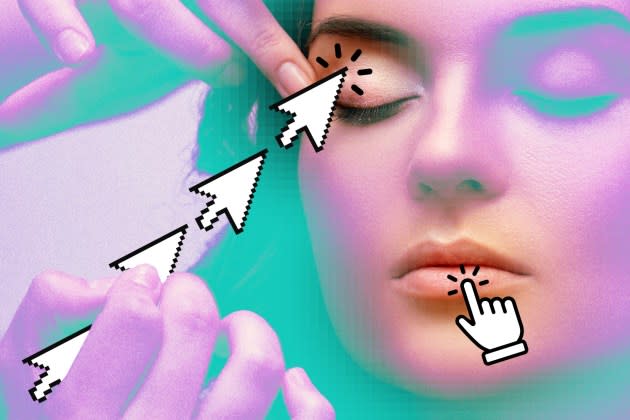Digital Cosmetics Is the A-List’s Most Guarded Beauty Secret

A digital makeup artists’ work may involve a computer keyboard rather than a makeup brush, but they are behind arguably the most closely held beauty secret among Hollywood A-listers.
The little-talked about artform — sometimes referred to as digital cosmetics or digital makeup — has a range of uses from story-driven requirements (i.e. it’s one method of de-aging an actor) to an actor’s personal taste (i.e. removal of bags under the eyes or an acne scar).
More from The Hollywood Reporter
“Almost every production has some amount of this work,” reveals one source who works in this space, who The Hollywood Reporter will refer to as Bob. Still, you’ll rarely hear about this work because those involved are under strict NDAs, which is one reason why these sources spoke to THR on the condition of anonymity, even though they spoke of this work in general terms and declined to name clients or projects.
Story-driven uses might also involve making an actor appear to be sick or giving them a “glow” as they fall in love. Other uses include technical needs such as removing a seam in a prosthetic or a visible tattoo, as well as subtle consistency fixes.
Then, there’s the work commissioned at an actors request. For example, one 50-something star of a pricey streaming drama took a few years off their appearance with digital makeup, according to a post-production source who does not work directly with digital makeup.
One digital-cosmetics artist who works with A-listers, who THR will call John, relates that requests based on personal taste “could be under eye bags and smile lines, and just the general things that catch highlights and shadows that you might want to reduce just to make somebody look like the most well-lit version of themselves.”
“I think they all look great,” the artist adds. “We all have something when we look in the mirror that we see that nobody else sees. And that’s what I’m fixing for that person.”
For those who work in this field, discretion is key. “This is the first I’ve ever spoken about what I do for a living,” John admits. “We keep it real close to the vests.”
Some actors grow accustomed to a specific digital makeup artist, and will use them from project to project.
“Sometimes it’s in an actor’s contract that they’re going to get a cosmetic pass,” John explains, adding that other times, “the actor would specify in their contract with the studio who would be doing their work for them.”
Particularly when they are requested in an A-lister’s contract, these digital artists are often working closely with a longtime, trusted member of the star’s team, such as a traditional makeup artist or an assistant. “They’ll be the ones ultimately approving things or the talent themselves might approve things,” John says.
Bob adds that other times, the actor may be directly involved. “Sometimes an A-list actor will sit in for the review and give notes,” he says.
Conversely, some actors stipulate in their contracts that no digital work will be done on them, because such assignments don’t always come from the actor. Particularly if the use is story-driven or for lighting purposes, it might come directly from the director, or even the cinematographer or visual effects supervisor.
“Typically, if it’s [an actor] that I’ve worked on before, I’ve got a good feel for what they’re looking for. And I just want to make sure that the DP or the VFX supervisor is on the same page because sometimes they’re not,” says John. “You have to know who you’re really working for.”
So how exactly does this all work? It’s primarily done with compositing techniques and in some cases could be thought of as a moving picture equivalent of Photoshop touch ups. Other times it might even involve fully-replacing a body part digitally, particularly if the work involves a large area.
Rates can vary greatly due to the scope of the work, with factors such as the number of shots required and the type of work. Bob relates that at the low end, a company might be looking at a few hundred dollars per shot if it involves a simple task such as removing a blemish. “If it’s extremely complicated, it could be tens of thousands or hundreds of thousands per shot,” Bob adds, citing as an example the removal of a tricky and highly-visible tattoo. He says companies might replace a full body part — such as an arm or neck — with a digital replica as a last resort. “At some point, it’s easier,” says Bob.
John relates that for work on the face, the bottom half of the face involves more intricate work because “anytime we’re working around the mouth, you have a lot more roto[scoping] work to do.”
As filmmaking techniques continue to evolve, it seems this sort of work may only grow in use. “It’s prevalent. And I don’t think it’s going to go away,” sums up Bob. “ I think it’s here to stay and it’s part of the [filmmaking] process.”
But for now, it remains in the shadows. “People know it exists, but it’s still kind of hush hush,” Bob adds. “I don’t think it’s this nefarious thing that [actors] are trying to pretend to be something else. I think it’s just another aspect of playing a character. It’s like stage makeup, hair, wig, makeup, digital makeup.”
Perhaps a true sign of these artist’s skills is they – like their work – remain behind the scenes.
Says John: “If you’re not perfect—if people know that you had work done—that’s worse than not doing anything.”
Best of The Hollywood Reporter

 Yahoo News
Yahoo News 